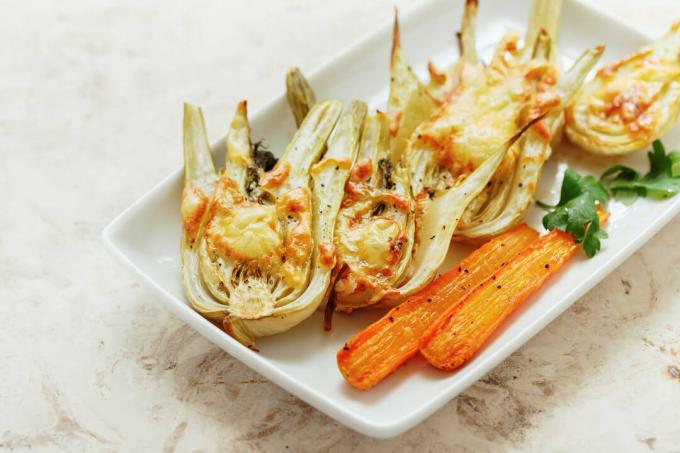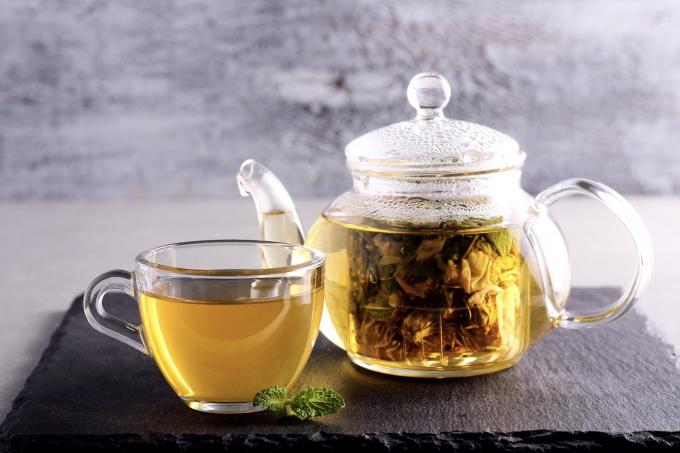Fennel is grown in the garden as a wholesome vegetable and spice. You can find out from us what to look out for when harvesting, storing and processing fennel.

fennel (Foeniculum vulgare) is known in three forms: as vegetable fennel, spice fennel or wild fennel. Harvesting and use of bulbous and tea fennel differ significantly, as either the tender bulbs or ripe seeds are harvested. In this article you will learn everything about the harvest time, storage and preparation of fennel and the medicinal properties of the Mediterranean vegetable and herb.
contents
- Harvest fennel
- Store and freeze fennel
-
Cutting fennel: preparation and processing
- Can you eat fennel raw?
- Is fennel stalk poisonous?
- How healthy is fennel?
- What medicinal properties should fennel have?
Harvest fennel
Fennel bulbs need a lot of warmth and sun to grow. Compared to warm Mediterranean countries, the plant needs more time here to develop the tasty tubers. It takes about ten to twelve weeks from sowing to harvesting fist-sized tubers. The finely pinnate leaves can be collected as a sweet, aromatic herb well into autumn and dried in the oven at 40 °C. At sentence by sentence
Sowing and planting fennel can be harvested continuously between the end of June and October. The harvest must take place at the latest at the end of October before the first frost, as it is fully grown In contrast to the young plant, tuber fennel can no longer withstand sub-zero temperatures without suffering damage from the cold to suffer. To harvest fennel, cut off the bulb about 2 to 3 cm below the root with a sharp knife or pruning shears. Alternatively, pull out the entire plant and just cut off the roots.
Can you still harvest fennel when it is in bloom? If the bulbous fennel has blossomed, it was probably planted too early and it is not a bolt-resistant variety. An overview of bolt-resistant and aromatic fennel varieties can be found in our special article. The tuber becomes lignified when it develops an inflorescence and is therefore hardly tender enough for the kitchen. You can harvest the fennel here early, as soon as you notice that it is going to flower, or you can let the seeds ripen. To harvest fennel seeds, cut off the whole umbels with secateurs early in the morning and leave them to dry at room temperature for a few days. The dry fennel seeds usually fall off the inflorescence by themselves and can be stored in dark and cool jars for several years. Fennel flowers provide food for numerous insects and the seeds can be used as a spice and medicinal, just like tea fennel and wild fennel.
Store and freeze fennel
Fresh fennel can be stored in the fridge, wrapped in a damp kitchen towel, for up to two weeks. Moist sand in combination with a cool location between 0 - 5 °C is also suitable for storing fennel. However, cleaning is much more complex here than with refrigerator storage. After briefly blanching chopped fennel pieces in boiling water, fennel can be frozen and then stored in the freezer for several months. After blanching, which takes 30 seconds to 2 minutes depending on the size of the pieces, the fennel is left to cool and then packed in airtight freezer bags or boxes. In principle, freezing is also possible without prior blanching. However, the short heat treatment extends the shelf life and aromas and nutrients last longer.

Cutting fennel: preparation and processing
Before preparing fennel, it should be cleaned, cutting out and removing any wilted, woody, or mushy parts. Cutting fennel is usually limited to removing the tough stalk. To do this, the fennel bulb is cut in half and the woody parts of the stalk are carefully cut out. Popular main courses are baked fennel halves from the oven, from the grill, cooked or fried in a vegetable pan. Recipes for fennel vegetables as an accompaniment to Mediterranean dishes can often be found in cookbooks.
There are several methods of preserving fennel. The herb and seeds can be dried and used as a spice or ingredient in fennel tea. High-proof absinthe and France's national liqueur Pastis owe their extraordinary taste to the fennel seeds. Fennel spice from seeds or leaves goes well with pickled vegetables and also creates a spicy note when baking bread. The aromatic bulbs, on the other hand, can be pickled, fermented or preserved to preserve the fennel. To do this, cut the fennel into fine strips or pieces and prepare the brew. The fennel pieces are filled into preserving jars, poured over with boiling hot water, brine or spice stock and quickly sealed tightly.

Which parts of the fennel plant are edible? All parts of the fennel plant are edible and harmless to humans and animals.
Can you eat fennel raw?
Fennel can be eaten raw and is therefore also served in raw vegetable salads or for dipping as a vegetable snack, similar to celery stalk (Apium graveolens var. dulce).
Is fennel stalk poisonous?
The entire fennel plant is edible and no part of the plant is poisonous. This means that the fennel stalk is also edible and therefore does not have to be removed or cut out.
How healthy is fennel?
Fennel is low in calories and high in fiber. The tubers contain significant amounts of the minerals iron and potassium. Particularly valuable ingredients of fennel are the high content of vitamins A, B, C and E, which outshines many other types of vegetables. The healthy fennel also contains many essential oils such as anethole, which is anise (Pimpinella anisum) reminiscent taste is responsible. Together with these essential oils, it is considered an extremely digestible vegetable and is also suitable for diets.

What medicinal properties should fennel have?
The healing, health-promoting effect of fennel lies primarily in the promotion of digestion. For flatulence, stomach pain, cramps and diarrhea, but also for diseases of the respiratory tract, such as Coughs, bronchitis and catarrh, as well as to loosen mucus, fennel can already be used in children will. The preparation as a fennel tea for babies and small children is particularly suitable here, which is gladly accepted thanks to the sweet taste. The daily dose for making tea is around 7.5 g of fennel seeds. Alternatively, fennel honey, a mixture of honey and bitter fennel oil, can be used for slightly older children.
In addition to positive properties for gastrointestinal complaints, fennel is also said to have a calming effect. Among other things, it is said to have a soothing effect on pregnancy symptoms, kidney stones, gout and eye inflammation. All of these healing effects have helped fennel to be named Medicinal Plant of the Year 2009.
A close relative of fennel and often found in combination with it is the Caraway seed (Carum carvi). With us you will learn everything about the properties, requirements and successful cultivation of the aromatic and medicinal plant.
